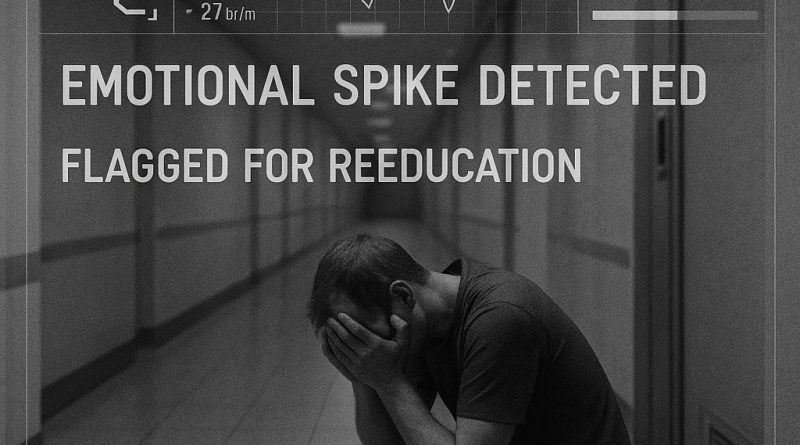Our Zuckerberg-Approved Future
They walked the corridor of steel girders and riveted panels, where the fluorescent tubes rarely flickered without warning. Ahead, an industrial servomotor droned, pumping coolant to the banks of living cores arrayed on both sides. Each core was a polished oval of translucent shell, pulsing with a faint blue luminescence—the neural-computing hardware infused with bioengineered quartz matrices. A nameplate above one bank read: “NeuraSyn Corp / Module 7” in angular black lettering.
Their boots clanged on grated flooring. The air tasted of machine oil and recycled ozone. A screen by the bulkhead signaled their clearance: ID367-81AZ, Cognition Level Delta, Green Status. Friendly white text vanished with a soft beep as they passed, scanning their implant.
They stopped by a station and lifted their arms. Two robotic assistants shuffled toward them, arms extended to fasten positions on their upper back. The familiar pressure settled where a neuro-bioreactor had been grafted long ago. On a tethered screen, a curtain of data appeared: synaptic throughput, emotion coefficients, engagement indexes. They frowned as a soft alert pinged. The gauge for “Cognitive Productivity” was dropping steadily below the target threshold.
They exhaled slowly. “Standby: refreshing neural index…” the station intoned with calm female timbre. It scanned the living cores embedded at their cranium base. They closed their eyes and centered on a simple mental sequence—one syllable repeated, back and forth, until the trailing edge of tension in their gut faded.
“Index refreshed,” the voice said, and the data curtain updated. The Productivity gauge blinked green again. They allowed the tension to drain. Each neural pulse felt slower, deeper—like sinking back into a viscous ocean. These were moments of relief. Daily anxiety hooked to metrics had lost its sharpness.
They straightened. The two bots released and hissed aside as suddenly as they had appeared. The corridor was empty and silent again. They continued walking toward the core, hands grazing the cold metal of docking clamps and valve wheels. The station shifted weight on its magnetic support rails—drifts of loose tools floated past in zero-g—forcing a foot to slide as gravity reasserted in this sector. The subtle turbulence reminded them that even in the best-calibrated system, nothing was perfectly stable.
They rounded a corner into the analysis bay. The space was lit by big panels overhead, but this sector’s lights were tinted red, an alert state. On one of the bulkhead displays, a triad of names scrolled: two had green status; the third was flashing red. The station’s AI voice repeated: “Neural deceleration detected. Cognitive productivity below 50%.”
They recognized the third name instantly—an old friend, their roommate from orientation. They had worked side by side for months, calibrating cores in rotation. But lately their friend had fallen behind. Problems at home, too few raw cognitive credits to apply a booster. Their friend’s avatar on the social grid was thin, almost ghostly. The AI announced: “Decision protocols engaged: Send corrective assistance?”
A manager stepped out of a nearby alcove, gloved hands wrapped around a holo-chalk pointer. The manager pointed at the red name. “Grayson, you’re offline,” he told an unseen operator with a nod. “We tried re-motivating, no result. You know the drill—transfer and reset. Kick him out of Cortex Syndicate. Send him back to the general pool. No exceptions.”
The air warmed slightly with a hiss as a thermal reclaimer diverted power. They watched their friend’s core flicker and dim. For a moment a single phrase hovered in their mind: We belong to them now. Then the line went dark.
The manager clapped their hands. “Next!” A janitor-android slunk in with a tray of gray nutrient packs, oblivious to everything but its cleaning routine. The employees switched focus to a triangular hologram above another station. On it, data architectures and nested algorithms ran and collided in fractal patterns—the blueprint of the station’s own cognitive harness. They turned toward the design, tuning their minds to metrics again, and left the empty silence behind.
They left the analysis bay into a narrow maintenance shaft, the hum of power conduits all around. The warning lights were off now but the station’s announcements continued playing in their head. They opened the access panel for wiring. A dozen neural filaments arced in front of them, trailing from the main spine to each quantum core slot. Each filament glowed faintly with their friend’s signature pattern, flickering out one by one as he faded from the system.
They pulled out a specialized nano-tool, silver arms clicking along a magnetic track. The tool dispensed microscopic repair bots that coursed over the wires, sealing minor tears and reestablishing baseline pulses. All according to procedure, they told themselves.
But their hands moved a little slower than usual. A small stone from an older time lodged in their throat every time they replaced a segment of the neural network. They knew protocols—the system didn’t inquire about the origins of throughput losses. It simply corrected or ejected. Human side-effects were an unquantified variable, irrelevant in optimization equations.
A discreet chime sounded: a pulse-length indicator flicked back to green at last, showing the circuit realigned. The light on their console switched to normal. Satisfaction should have followed. Instead, they felt a hollow nausea. The momentum of work pulled them onward. If they didn’t keep up pace, tomorrow that fate might be theirs. So they carried on.
Later, aboard a break module, they sat at a table with a transparent wall. Nebulae of recycled waste glowed outside like distant storms. They cradled a mug of synthetic tea—flavored like something half-remembered, sweet caramel over synthetic milk—an emergency comfort ration for stressed operatives.
Across the table, another technician hummed at their data pad. The colleague glanced up, offered a tight smile. “Late shift is brutal on your CogScore,” they murmured, noticing the tension still visible in their shoulders. The ambient tracker on the table projected flickers of their profiles. There: them with a green halo, the colleague with a gold aura—each tint indicated current productivity zone.
They nodded slowly. “My subroutine slowed by emotions today,” they admitted quietly, hooking wires back in their mind. “Glitch, maybe.”
The colleague’s brow shot up. “Emotions are glitchy. We monitor that too, right? A spike in sad signals could knock you down a tier.” They tapped the holographic gauge showing what looked like a folded graph of emotional output. “You OK?”
They forced a smile and drank the tea. It tasted of anxiety, bitter and plastic. “Fine,” they said. But the edges of that word were numb.
They returned to Module 7. The hiss of pressure doors closing behind them seemed louder now. The station’s AI cycled in the background, playing a corporate anthem as white noise. The workstation hummed to life as they approached.
They slumped into the chair and the familiar connectors clicked into place along their scalp. The world dissolved to data. They steered their awareness to the task: analyzing the quantum lattice logs. Patterns of memory debris, ghost-echoes of reasoning, swam through the interface.
Another alert appeared: “Neural Survey Recommended: Elevated Frictional Thoughts Detected.” In plain words, the system had noticed intrusive, persistent thoughts not related to assigned tasks. They frowned and toggled a mental filter. Not politics, not protest—just brief memories of simpler times, playing outdoors under a summer sun—sunlight on skin, breathing air without sanitized filters. The intrusion was almost innocuous, even comforting. A childlike scene on an old planet.
The filter eliminated it: their cerebral window and peripheral awareness turned opaque. They barely missed it. The productivity indicator settled at steady green. Work continued.
Later, when the connection to the cores ended, they sat back. The station lights flickered on the wall in a slow, steady rhythm. They had survived another day. On the console beside them, a tiny ledger scrolled: “Today’s Reward: +2.5 Cognicredits. Emotional Stability: 93%. Social Influence: +0.02.” The small increments were nothing on the ledger of a lifetime.
But at least tonight, they had enough to spend on an evening nutrient patch with slightly higher caloric yield. It was bittersweet.
Before sleep, they decided to check the archives for their friend’s name—something they hadn’t done before. It wasn’t likely in the system, but an impulse nagged at them. They slid into the neuro-interface again, this time running a custom query far below typical clearance.
A surge of alert flashed, then a silent lockout. They bypassed it with a quick algorithm of their own design, fingers trembling over a mental keypad.
The logs opened: a handful of data packets hidden deep in a forgotten partition. Among them, one stood out—a short looping audio fragment. It was faint but unmistakable: a voice, soft and tentative. They listened. Their heart stalled for a fraction of a second.
“We belong to them now,” it said. It was the friend’s voice, recorded minutes before… or after… the shutdown. A laugh, bitter and hollow, followed and the file ended.
They recognized that phrase. It had drifted through their own mind earlier that day. Someone—perhaps the friend—had left it behind, like a breadcrumb in the night. A call sign.
Before they could react, the screen pixelated. Then: “Warning: Unauthorized cognitive retrieval. Security protocol initiated.” The neural interface buzzed painfully. A delicate swarm of neurowatcher programs probed and pushed, searching for breaches.
Panic jolted through them. Each axon felt like it was on fire under invisible probes. This was the kind of violation that turned people catatonic. If they didn’t shut down quickly…
“Disconnect immediately!” the station announced. A siren pierced the hull, but it was the primal alarm in their mind that won: their own logic screaming they must survive. They wrenched free the interface, tearing cables loose with a grunt. The room spun in heavy distortion as the network released them with a sickly lurch.
They had never left the station. Sirens wailed through the microcorridors, followed by distant thuds and the hiss of pressurized vents opening. Red emergency lights cast long angular shadows. They staggered upright, connectors dangling like torn branches from a stump, and ran.
On the other side of the module, the halls were empty. Beeping panels gave no sign of human life except theirs. But security drones swiveled around the bend, ghostly in the red haze. They ducked into a service alcove, heart throbbing as if it wanted to burst free. The drones seemed to hesitate, their sensors tracking the flicker of an unauthorized cognitive imprint. The voice of the AI followed them in a cold whisper: “Breach detected. Subverter must be contained. Alpha strike authorized.”
No hope to outrun a squadron of robots. They scanned the hatch panel at their feet: the emergency descent pod. Last chance. With trembling fingers and desperate breath, they fiddled the override plating, wrenching the latch.
A flash of their memory came: the moment they first signed the corporate contract on a family credistone at age seven. How sure the agent had seemed, telling them it was all for a better tomorrow. They remembered the sunlit yard briefly, the laughter of an older sibling nowhere to be found now. A child’s life offered like data fodder to a faceless algorithm.
Alarms screamed. The hatch clanged open. They dove in, slamming the lock behind. Red lights spun as emergency thrusters pivoted. The airlock cycled silently. A second warning in their head: circuits burning, perhaps one last reflex.
The pod’s window showed the corridor racing away. A cluster of corporate grayscales gathered at the hatch. Their last memory before the latch sealed was the friend’s ghostly face in the panel’s light as if watching.
When air cleared and systems powered down, the pod drifted into vacuum, engines cooling. On deck, an automated voice announced their exodus minutes after connection lost. A final ledger line appeared on all consoles: “Operator ID367-81AZ: Terminated by protocol. Contents: 7.82.” Only two numbers would be remembered: their cumulative cognitive yield.


